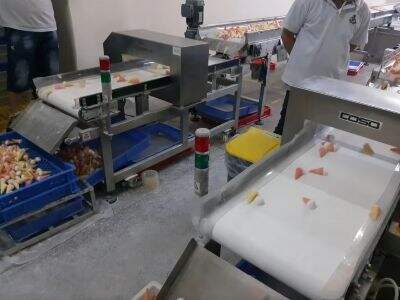In order to keep our food free of contaminants metal detectors are important to use to enable ensure that the food we consume in our daily diet is free from harmful metal objects. There are different type of metal detectors,In line metal detectors,Food metal detectors,Conveyor Metla detectors,pipline food metal detectors. It can be useful to learn the differences between each and to gain a better understanding as to which is likely to be the most suitable for use within a food production environment.
The differences between food metal detectors machines produced with a conveyor belt and pipeline technology:
Metal detectors designed for conveyor belts feed into the end of the conveyor belt system where product is passing through to packaging. These detectors are able to inspect large amounts of food products passing on the conveyor belt fast and effective. In contrast, pipeline foods metal detectors are mounted into the actual pipeline which runs food products. This enables the food to be scanned constantly as it passes through the pipeline.
Consider the Following to Determine Whether a Conveyor Belt or Pipeline Metal Detector is Right for Your Application:
There are several considerations in selecting between the two types of metal detectors, conveyor belt or pipeline. One thing to consider is the dimensions and geometry of the food products, which are transported and handled. Conveyor band metal detectors are best for large, hard products, while pipeline metal detector machine work best with liquid or paste products. The speed of manufacture is also a consideration. Conveyor belt and pipeline metal detectors can be faster (ideal for high-speed production lines) or slower (more suitable for continuous processing).
Conveyor Belt vs. Pipeline Metal Detectors Efficiency & Effectiveness Comparison:
Conveyor belt and pipeline metal detectors are both suitable for detecting metal contamination in food stuff. Conveyor belt metal detector machine, however, may be more convenient in that they are quicker to use. They are capable of scanning lots of food on a conveyor belt at once, which makes them perfect for high-capacity production. In contrast pipeline metal detectors constantly scan food products as they pass through the pipeline, and so each product is fully examined.
The pros and cons of conveyor belt vs food pipeline metal detectors:
Conveyor belt metal detectorscan provide a fast and effective inspection of food products to minimize contamination of consumers product. They also may be limited as far as the size and dimensions of items that can be visually inspected. Pipeline particle sizers, meanwhile, monitor liquid or paste product continuously, reducing potential contamination. But they could be less “set it and forget it” than conveyor belt metal detector.
Choosing the Best Metal Detector for Your Food Processing Facility – Recommendations:
When you’re choosing a metal detector for your food production line, you should also keep in mind the demands of your facility. Considering size and shape of food, also production capacity. You should research what types of metal detectors are to choose from and make that best suits for your production needs and requirement. It is also very important to have your metal detector regularly tested and frequently calibrated to be certain it is correctly detecting metal contaminants in your food products.
Table of Contents
- The differences between food metal detectors machines produced with a conveyor belt and pipeline technology:
- Consider the Following to Determine Whether a Conveyor Belt or Pipeline Metal Detector is Right for Your Application:
- Conveyor Belt vs. Pipeline Metal Detectors Efficiency & Effectiveness Comparison:
- The pros and cons of conveyor belt vs food pipeline metal detectors:
- Choosing the Best Metal Detector for Your Food Processing Facility – Recommendations:

















































